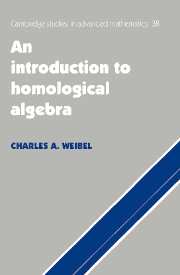Book contents
- Frontmatter
- Acknowledgments
- Contents
- Introduction
- 1 Chain Complexes
- 2 Derived Functors
- 3 Tor and Ext
- 4 Homological Dimension
- 5 Spectral Sequences
- 6 Group Homology and Cohomology
- 7 Lie Algebra Homology and Cohomology
- 8 Simplicial Methods in Homological Algebra
- 9 Hochschild and Cyclic Homology
- 10 The Derived Category
- A Category Theory Language
- References
- Index
8 - Simplicial Methods in Homological Algebra
Published online by Cambridge University Press: 05 March 2013
- Frontmatter
- Acknowledgments
- Contents
- Introduction
- 1 Chain Complexes
- 2 Derived Functors
- 3 Tor and Ext
- 4 Homological Dimension
- 5 Spectral Sequences
- 6 Group Homology and Cohomology
- 7 Lie Algebra Homology and Cohomology
- 8 Simplicial Methods in Homological Algebra
- 9 Hochschild and Cyclic Homology
- 10 The Derived Category
- A Category Theory Language
- References
- Index
Summary
By now, the reader has seen several examples of chain complexes in which the boundary maps Cn → Cn−1 are alternating sums d0 − d1 + … ± dn. The primordial example is the singular chain complex of a topological space X; elements of Cn(X) are formal sums of maps f from the n-simplex Δn into X, and di (f) is the composition of f with the inclusion Δn−1 ⊂ Δn of the ith face of the simplex (1.1.4). Other examples of this phenomenon include Koszul complexes (4.5.1), the bar resolution of a group (6.5.1), and the Chevalley-Eilenberg complex of a Lie algebra (7.7.1). Complexes of this form arise from simplicial modules, which are the subject of this chapter.
Simplicial Objects
Let Δ be the category whose objects are the finite ordered sets [n] = {0 < 1 < … < n} for integers n ≥ 0, and whose morphisms are nondecreasing monotone functions. If A is any category, a simplicial object A in A is a contravariant functor from Δ to A, that is, A: Δop → A. For simplicity, we write An for A([n]). Similarly, a cosimplicial object C in A is a covariant functor C: Δ → A, and we write An for A([n]). A morphism of simplicial objects is a natural transformation, and the category S A of all simplicial objects in A is just the functor category AΔop.
Information
- Type
- Chapter
- Information
- An Introduction to Homological Algebra , pp. 254 - 299Publisher: Cambridge University PressPrint publication year: 1994
